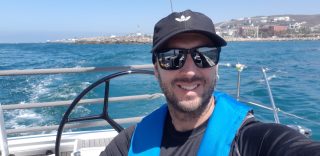English translation below.
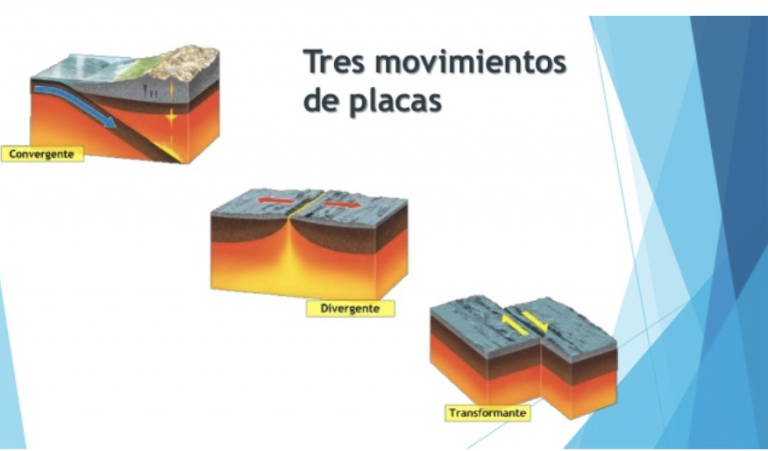
Existen tres límites principales de placas tectónicas: Divergente, es el lugar en donde dos placas se separan, lo que origina que el material del manto ascienda y se forme un nuevo fondo oceánico de la litósfera oceánica. Convergente, donde la corteza se destruye cuando una placa se sumerge debajo de otra. Transformante, es una zona de tensión cortante o de cizallamiento, donde una placa se desliza lateralmente respecto de la otra, en este tipo de bordes no se crea ni se destruye litósfera (Figura 1).
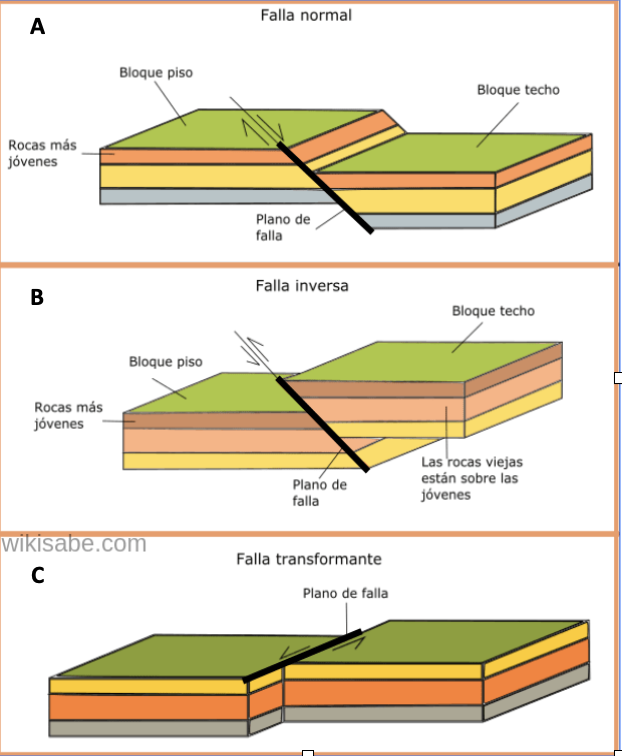
Por otro lado, las fallas son fracturas en la corteza a lo largo de las cuales ha tenido lugar un desplazamiento apreciable. Las fallas con desplazamiento vertical se clasifican como fallas normales cuando el bloque de techo se desplaza hacia abajo en relación con el bloque de muro, y las fallas inversas cuando el bloque de techo se mueve hacia arriba con respecto al bloque de muro. Por último, las fallas transformantes, donde el desplazamiento dominante es horizontal y paralelo a la dirección de la superficie de la falla (Figura 2).
Antecedentes
El Golfo de California (GC) es un sistema de rift activo con deformación transtensional entre un movimiento de límites de placa divergente y transformante con orientación NW-SE de ~1500 km de longitud y ~200 km de ancho, definido por un arreglo de fallas transformantes lateral derecha que conectan una serie de cuencas tipo pull-apart a partir del Mioceno Medio-Tardío (Figura 3).
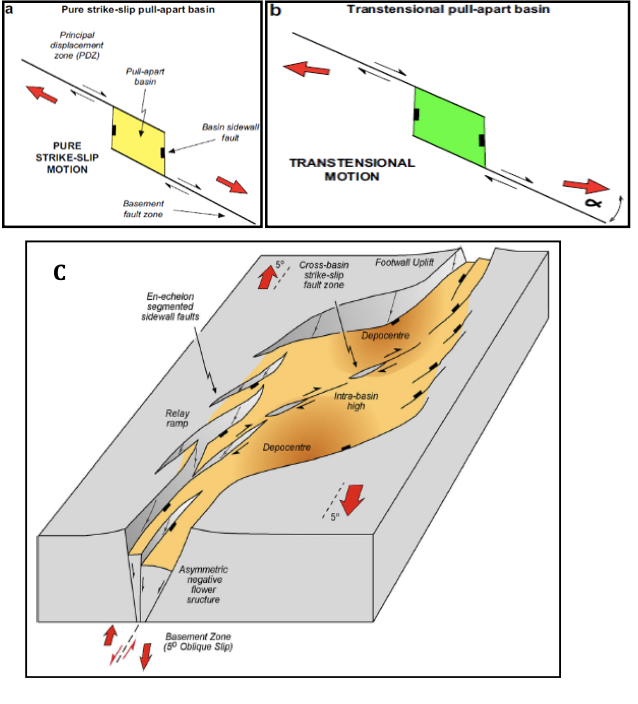
En estas cuencas prevalecen ambientes que van desde transicionales y neríticos hasta ambientes pelágicos. La región norte del golfo ilustra los efectos de un gran volumen de sedimentación ocurrida durante el adelgazamiento y la ruptura del manto litosférico, se caracteriza por conectar cuencas activas al oeste (Delfin, Consag, Wagner, Cerro Prieto y Salton) e inactivas al este (Tiburón y Aldair-Tepoca), amplias y someras con paquetes de sedimentos de hasta 6 km, producto del aporte de terrígenos provenientes del río Colorado, desde el Mioceno Medio-Tardío hasta el Reciente (Figura 4).
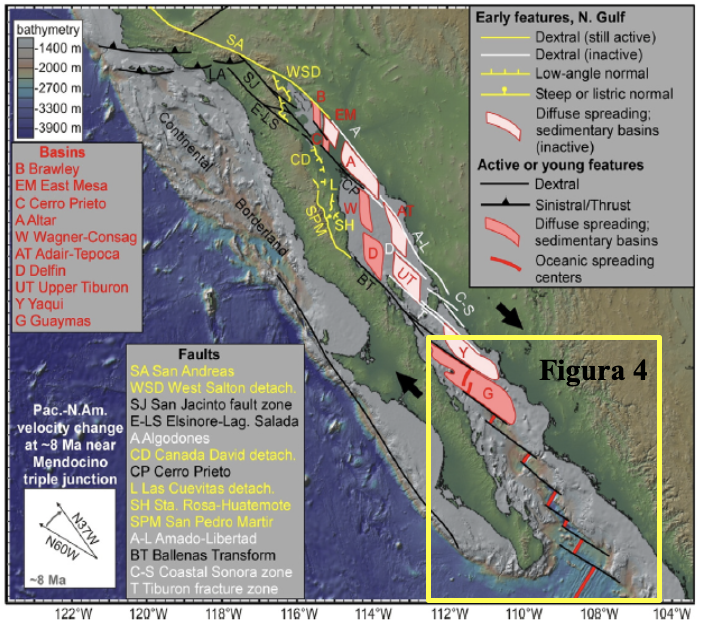
En contraste, la parte central y sur del golfo está caracterizada por grandes tirantes de agua, cuencas estrechas y alargadas, con espesores sedimentarios de hasta 1 km, y conectadas por un arreglo bien definido de fallas transforme dextral, que se desarrollan sobre corteza transicional y oceánica (cuencas Guaymas, Carmen, Farallón y Pescadero). Más al sur, la cuenca Alarcón forma parte de un sistema distinto, en donde se ha mostrado la formación de nuevo piso oceánico desde hace ~3.5 Ma. Esta cuenca se caracteriza por presentar una tasa de dispersión de ca. 48 mm/año y anomalías magnéticas bien definidas que se extienden hacia el Pacífico (Figura 5).
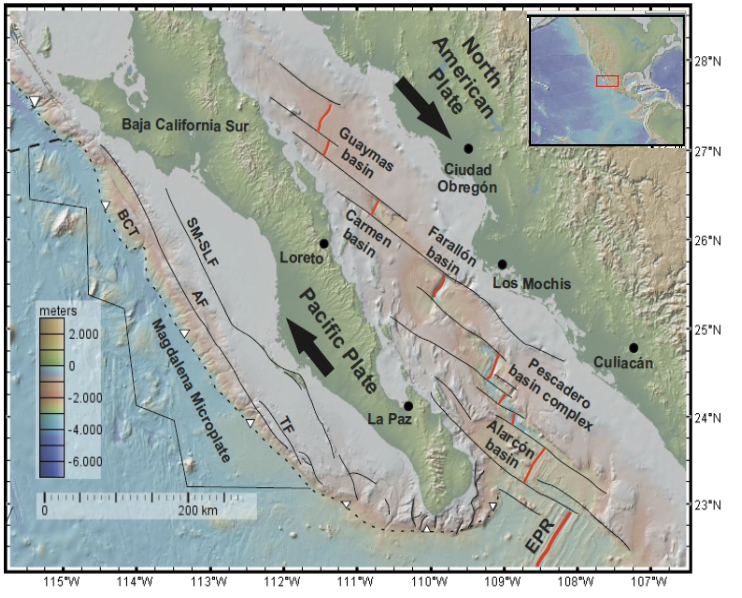
Durante el Cenozoico la placa farallón fue consumida debajo de la placa de Norteamérica. Una parte de la placa Norteamérica se acopló a la placa del Pacífico y desde entonces ha sido arrastrada hacia el noroeste dando inicio a la ruptura continental. Con este evento se dio inicio a una extensión temprana en el Oligoceno tardío al Mioceno temprano, (Ferrrari et al., 2018). La placa Farallón terminó el proceso de subducción al final del Mioceno medio y la primera formación de corteza oceánica en el GC durante el Plioceno Temprano (Figura 6) (Negrte-Aranda et al., 2013).

Evolución tectónica del Golfo de California
El modelo de evolución cinemático de apertura en dos fases del Golfo de California propuesto por Stock y Hodges (1989), sugiere un periodo inicial de extensión casi ortogonal con transporte tectónico de ~90 km, formando un proto-golfo durante el Mioceno medio. Posteriormente cambió a un sistema de cizalla transtensional, con un desplazamiento de ~300 km durante el Mioceno tardío, en donde toma lugar la separación de Baja California, la formación de la corteza transicional en la región norte y la subsecuente generación de nuevo piso oceánico en la región sur. En contraste, el modelo de apertura del Golfo de California en una fase (e.g., Fletcher et al., 2007) sugiere un movimiento relativo único de cizalla dextral transtensiva desde el Mioceno medio hasta el Reciente, donde se requiere un desplazamiento de 450-500 km (de los cuales 150-200 km tuvieron lugar antes de 6 Ma) entre la península de Baja California y la porción occidental continental de México (Figura 7).
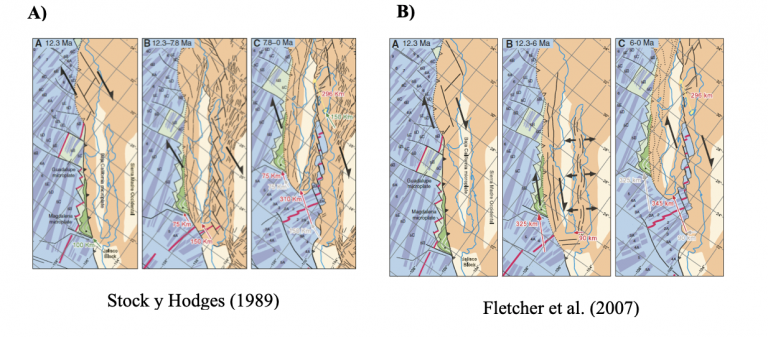
Otro modelo propuesto por Ferrari et al. (2013) sugiere que, en las etapas iniciales de la deformación, gran parte de la magnitud del adelgazamiento cortical para formar el GC ocurrió por extensión tras-arco que inició en el Oligoceno hace ~30 Ma, previo a la reorganización dextral transtensiva de la frontera de placas Pacífico-Norteamérica hace ~12 Ma (Figura 8).
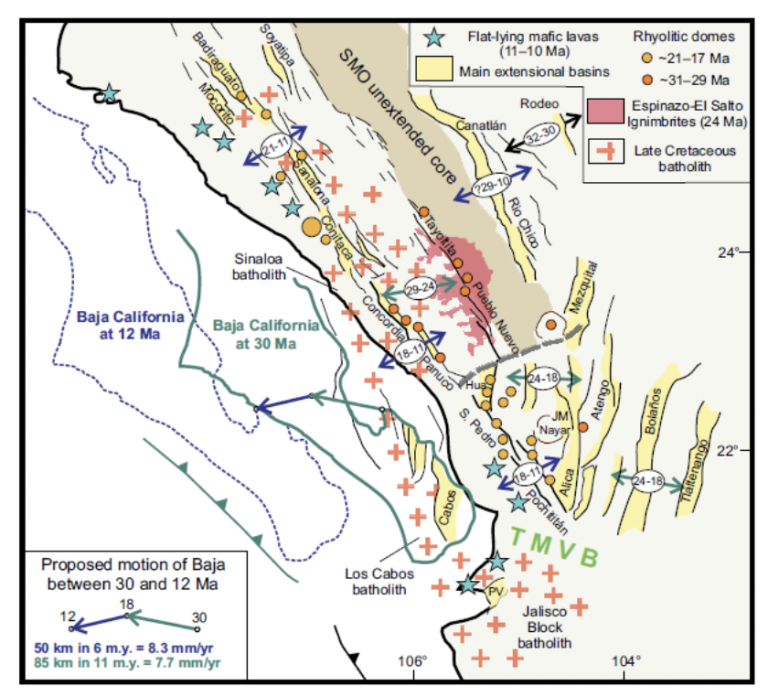
Bibliografía
Ferrari, L., López-Martínez, M., Orozco-Esquivel, T., Bryan, S.E., Duque-Trujillo, J., Lonsdale, P., Solari, L., 2013. Late Oligocene to middle Miocene rifting and synextensional magmatism in the southwestern Sierra Madre Occidental, Mexico: the beginning of the Gulf of California rift. Geosphere 9:1161–1200. http://dx.doi.org/10.1130/ GES00925.1.
Ferrari, L., Orozco-Esquivel, T., Bryan, S. E., Lopez-Martinez, M., & Silva-Fragoso, A. (2018). Cenozoic magmatism and extension in western Mexico: Linking the Sierra Madre Occidental silicic large igneous province and the Comondú Group with the Gulf of California rift. Earth-Science Reviews, 183, 115-152.
Fletcher, J.M., Grove, M., Kimbrough, D., Lovera, O., Gehrels, G.E. (2007). Ridge trench interactions and the Neogene tectonic evolution of the Magdalena shelf and southern Gulf of California: Insights from detrital zircon U-Pb ages from the Magdalena fan and adjacent areas: Geological Society of America Bulletin, 119(11-12), 1313-1336.
Negrete-Aranda, R., Contreras, J., Spelz, R. M. (2013). Viscous dissipation, slab melting, and post-subduction volcanism in south-central Baja California, Mexico: Geosphere, 9(6), 1714-1728.
Stock, J.M., Hodges, K.V. (1989). Pre-Pliocene extension around the Gulf of California and the transfer of Baja California to the Pacific plate: Tectonics, 8(1), 99-115.
Van Wijk, J., Axen, G., & Abera, R. (2017). Initiation, evolution and extinction of pull-apart basins: Implications for opening of the Gulf of California. Tectonophysics, 719, 37-50.
Wu, J. E., McClay, K., Whitehouse, P., & Dooley, T. (2009). 4D analogue modelling of transtensional pull-apart basins. Marine and Petroleum Geology, 26(8), 1608-1623.
Geologic History of the Gulf of California Basins
There are three main tectonic plate boundaries: Divergent, where two plates separate, causing mantle material to rise and form a new ocean floor of oceanic lithosphere. Convergent, where crust is destroyed as one plate dives beneath another. Transform, is a zone of shear stress or shearing, where one plate slides laterally with respect to the other, in this type of edge neither lithosphere is created nor destroyed (Figure 1). Faults, on the other hand, are fractures in the crust along which appreciable displacement has taken place. Faults with vertical displacement are classified as normal faults when the roof block moves downward relative to the wall block, and reverse faults when the roof block moves upward relative to the wall block. Finally, transform faults, where the dominant displacement is horizontal and parallel to the direction of the fault surface (Figure 2).
Background
The Gulf of California (GC) is an active rift system with transtensional deformation between divergent and transform plate boundary movement with NW-SE orientation ~1500 km long and ~200 km wide, defined by an array of right-lateral transform faults connecting a series of pull-apart basins beginning in the Middle-Late Miocene (Figure 3).
In these basins, environments ranging from transitional and neritic to pelagic environments prevail. The northern region of the gulf illustrates the effects of a large volume of sedimentation that occurred during the thinning and rupture of the lithospheric mantle, characterized by connecting active basins to the west (Delfin, Consag, Wagner, Cerro Prieto and Salton) and inactive basins to the east (Tiburón and Aldair-Tepoca), wide and shallow with sediment packages of up to 6 km, product of terrigenous input from the Colorado River, from the Middle-Late Miocene to the Recent Miocene (Figure 4). In contrast, the central and southern part of the gulf is characterized by large water courses, narrow and elongated basins, with sedimentary thicknesses of up to 1 km, and connected by a well-defined arrangement of dextral transform faults, which develop over transitional and oceanic crust (Guaymas, Carmen, Farallón and Pescadero basins). Further south, the Alarcón basin is part of a different system, where the formation of a new oceanic floor has been shown since ~3.5 Ma. This basin is characterized by a spreading rate of ca. 48 mm/yr and well-defined magnetic anomalies that extend into the Pacific (Figure 5).
During the Cenozoic the Farallon plate was consumed beneath the North American plate. A part of the North American plate was coupled to the Pacific plate and has since been dragged northwestward initiating continental rifting. With this event an early extension in the late Oligocene to early Miocene was initiated, (Ferrrari et al., 2018). The Farallon plate ended the subduction process at the end of the middle Miocene and the first oceanic crust formation in the GC during the Early Pliocene (Figure 6) (Negrte-Aranda et al., 2013).
Tectonic evolution of the Gulf of California
The two-phase opening kinematic evolution model of the Gulf of California proposed by Stock and Hodges (1989) suggests an initial period of nearly orthogonal extension with ~90 km tectonic transport, forming a proto-gulf during the middle Miocene. Subsequently, it changed to a transthrustal shear system, with a ~300 km displacement during the late Miocene, where the separation of Baja California, the formation of the transitional crust in the northern region and the subsequent generation of a new oceanic floor in the southern region took place. In contrast, the one-stage Gulf of California opening model (e.g., Fletcher et al., 2007) suggests a single relative movement of transtensional dextral shear from the middle Miocene to the Recent, where a 450-500 km displacement (of which 150-200 km took place before 6 Ma) is required between the Baja California peninsula and the western continental portion of Mexico (Figure 7). Another model proposed by Ferrari et al. (2013) suggests that, in the initial stages of deformation, much of the magnitude of cortical thinning to form the GC occurred by behind-arc extension that began in the Oligocene ~30 Ma ago, prior to transtensional dextral reorganization of the Pacific-North American plate boundary ~12 Ma ago (Figure 8).
References
Ferrari, L., López-Martínez, M., Orozco-Esquivel, T., Bryan, S.E., Duque-Trujillo, J., Lonsdale, P., Solari, L., 2013. Late Oligocene to middle Miocene rifting and synextensional magmatism in the southwestern Sierra Madre Occidental, Mexico: the beginning of the Gulf of California rift. Geosphere 9:1161–1200. http://dx.doi.org/10.1130/ GES00925.1.
Ferrari, L., Orozco-Esquivel, T., Bryan, S. E., Lopez-Martinez, M., & Silva-Fragoso, A. (2018). Cenozoic magmatism and extension in western Mexico: Linking the Sierra Madre Occidental silicic large igneous province and the Comondú Group with the Gulf of California rift. Earth-Science Reviews, 183, 115-152.
Fletcher, J.M., Grove, M., Kimbrough, D., Lovera, O., Gehrels, G.E. (2007). Ridge trench interactions and the Neogene tectonic evolution of the Magdalena shelf and southern Gulf of California: Insights from detrital zircon U-Pb ages from the Magdalena fan and adjacent areas: Geological Society of America Bulletin, 119(11-12), 1313-1336.
Negrete-Aranda, R., Contreras, J., Spelz, R. M. (2013). Viscous dissipation, slab melting, and post-subduction volcanism in south-central Baja California, Mexico: Geosphere, 9(6), 1714-1728.
Stock, J.M., Hodges, K.V. (1989). Pre-Pliocene extension around the Gulf of California and the transfer of Baja California to the Pacific plate: Tectonics, 8(1), 99-115.
Van Wijk, J., Axen, G., & Abera, R. (2017). Initiation, evolution and extinction of pull-apart basins: Implications for opening of the Gulf of California. Tectonophysics, 719, 37-50.
Wu, J. E., McClay, K., Whitehouse, P., & Dooley, T. (2009). 4D analogue modelling of transtensional pull-apart basins. Marine and Petroleum Geology, 26(8), 1608-1623.
